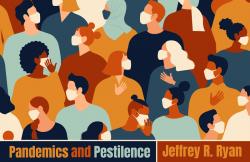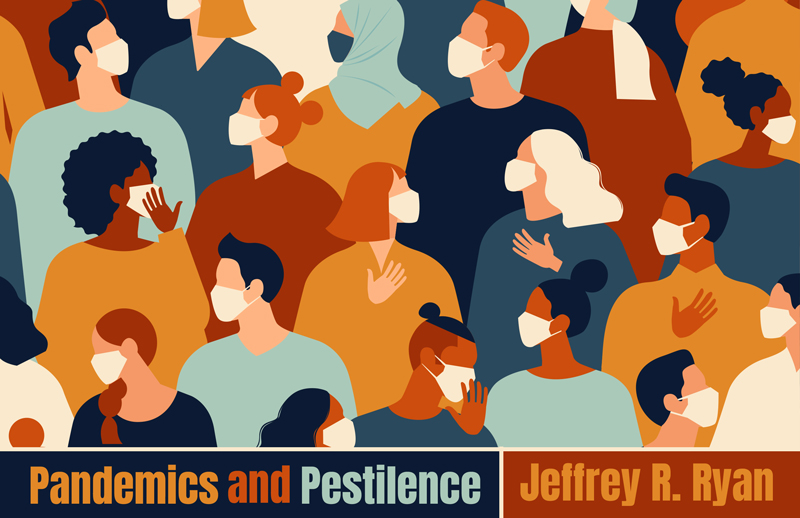Pandemics and Pestilence
Author(s): Jeffrey Ryan
Edition: 1
Copyright: 2021
In the event of an outbreak of a highly pathogenic and transmissible disease, community officials, planners, healthcare providers and first responders at all skill levels will be called upon to protect the public. Recognition of an emerging infectious disease (EID) threat will most likely come from public health authorities who have surveillance programs in effect in many parts of the world.
Emergency planning and management level responders, healthcare providers and community officials at all levels should be involved in the preparation for and response to a possible outbreak of a deadly contagion. Pandemics and Pestilence educates practitioners and professionals who are faced with challenges posed by the threat of an EID with pandemic potential. This enables the reader to better understand the threat of infectious diseases and the roles they play in preparing their communities and their employees for a disease outbreak that has great potential for morbidity and mortality. These professionals and practitioners are responsible for assembling comprehensive and effective plans to prepare for the challenges of an EID. They will also generate local plans and guidelines designed to conduct mass vaccination; to transport patients; to enforce isolation and quarantine protocols; to care for the sick; to remove and transport the dead; and, to evaluate the progress of any actions taken to ensure response objectives are met safely, effectively, and efficiently.
Pandemics and Pestilences give readers an understanding of the threat of EID with pandemic potential. In addition, it provides the reader with an understanding of outbreak containment and response skills, enabling him or her to effectively plan and prepare for an outbreak of an EID. It also empowers him or her to safely respond to a pandemic. Pandemics and Pestilence provides readers with information regarding the imminent threat of infectious disease, its challenges, and all the facets of effective preparedness, response, mitigation, and recovery.
Pandemics and Pestilence gives readers a full understanding of pandemic events – including the burden of infectious diseases, the history of major pandemics, the dynamics of transmission, and how communities prepare for, respond to, mitigate against, and recover from pandemic events.
Readers of Pandemics and Pestilence will learn to:
- Describe the burden of infectious disease and perils associated with pandemics
- Describe the types of pathogens and associated implications for human and animal health
- Discuss pandemic planning and preparedness activities that lead to the creation of a functional plan
- Describe the response actions of various emergency services disciplines and public health as they relate to testing, case identification, pre-hospital transport and fatality management during a pandemic event
- Discuss strategies for rapidly expanding the capacity of an existing health care system in order to provide critical care during a pandemic event
- Discuss mitigation strategies that are effective in limiting the spread of a pandemic threat
- Discuss the goals and programs needed in short- and long- term recovery from post-pandemic events
Chapter 1 The Burden of Infectious Disease
Chapter 2 The Origins and Dynamics of Pandemic Events
Chapter 3 Pandemic Preparedness and Mitigation
Chapter 4 Pandemic Response
Chapter 5 Mass Prophylaxis and Medical Surge
Chapter 6 Pandemic Recovery
Dr. Jeff Ryan is a retired U.S. Army Lieutenant Colonel with an extensive background in disaster response, preventive medicine, epidemiology, clinical trials, and diagnostics development. Dr. Ryan also served in the private sector working for a biotech company, Cepheid, where he was a senior business developer and manager for their biothreat government business program. Dr. Ryan has authored more than 45 scientific, peer reviewed journal articles and was the lead instructor and co-developer of the Pandemic Influenza Planning and Preparedness course, which was taught at the Center for Domestic Preparedness (CDP) in Anniston, AL. In addition, Dr. Ryan has served as certified instructor and curriculum developer at the CDP for numerous FEMA and CDC courses. He authored the textbook Biosecurity and Bioterrorism: Containing and Preventing the Biological Threat. In addition, he co-authored and edited Pandemic Influenza: Emergency Planning and Community Preparedness (2008) and Hazard Mitigation in Emergency Management (2015). Dr. Ryan served as Professor and Head of the Department of Emergency Management at JSU. Currently, he serves as Chief of Program Operations for Jacksonville State University and he also leads the University’s COVID-19 Task Force. Dr. Ryan has a Doctorate in Medical and Veterinary Entomology and a Master of Science in Biochemistry. Dr. Ryan is a recipient of the U.S. Army’s Legion of Merit and was awarded the U.S. Surgeon General’s Exemplary Service Medal for leading the Army’s preventive medicine efforts in Hurricane Andrew relief.
In the event of an outbreak of a highly pathogenic and transmissible disease, community officials, planners, healthcare providers and first responders at all skill levels will be called upon to protect the public. Recognition of an emerging infectious disease (EID) threat will most likely come from public health authorities who have surveillance programs in effect in many parts of the world.
Emergency planning and management level responders, healthcare providers and community officials at all levels should be involved in the preparation for and response to a possible outbreak of a deadly contagion. Pandemics and Pestilence educates practitioners and professionals who are faced with challenges posed by the threat of an EID with pandemic potential. This enables the reader to better understand the threat of infectious diseases and the roles they play in preparing their communities and their employees for a disease outbreak that has great potential for morbidity and mortality. These professionals and practitioners are responsible for assembling comprehensive and effective plans to prepare for the challenges of an EID. They will also generate local plans and guidelines designed to conduct mass vaccination; to transport patients; to enforce isolation and quarantine protocols; to care for the sick; to remove and transport the dead; and, to evaluate the progress of any actions taken to ensure response objectives are met safely, effectively, and efficiently.
Pandemics and Pestilences give readers an understanding of the threat of EID with pandemic potential. In addition, it provides the reader with an understanding of outbreak containment and response skills, enabling him or her to effectively plan and prepare for an outbreak of an EID. It also empowers him or her to safely respond to a pandemic. Pandemics and Pestilence provides readers with information regarding the imminent threat of infectious disease, its challenges, and all the facets of effective preparedness, response, mitigation, and recovery.
Pandemics and Pestilence gives readers a full understanding of pandemic events – including the burden of infectious diseases, the history of major pandemics, the dynamics of transmission, and how communities prepare for, respond to, mitigate against, and recover from pandemic events.
Readers of Pandemics and Pestilence will learn to:
- Describe the burden of infectious disease and perils associated with pandemics
- Describe the types of pathogens and associated implications for human and animal health
- Discuss pandemic planning and preparedness activities that lead to the creation of a functional plan
- Describe the response actions of various emergency services disciplines and public health as they relate to testing, case identification, pre-hospital transport and fatality management during a pandemic event
- Discuss strategies for rapidly expanding the capacity of an existing health care system in order to provide critical care during a pandemic event
- Discuss mitigation strategies that are effective in limiting the spread of a pandemic threat
- Discuss the goals and programs needed in short- and long- term recovery from post-pandemic events
Chapter 1 The Burden of Infectious Disease
Chapter 2 The Origins and Dynamics of Pandemic Events
Chapter 3 Pandemic Preparedness and Mitigation
Chapter 4 Pandemic Response
Chapter 5 Mass Prophylaxis and Medical Surge
Chapter 6 Pandemic Recovery
Dr. Jeff Ryan is a retired U.S. Army Lieutenant Colonel with an extensive background in disaster response, preventive medicine, epidemiology, clinical trials, and diagnostics development. Dr. Ryan also served in the private sector working for a biotech company, Cepheid, where he was a senior business developer and manager for their biothreat government business program. Dr. Ryan has authored more than 45 scientific, peer reviewed journal articles and was the lead instructor and co-developer of the Pandemic Influenza Planning and Preparedness course, which was taught at the Center for Domestic Preparedness (CDP) in Anniston, AL. In addition, Dr. Ryan has served as certified instructor and curriculum developer at the CDP for numerous FEMA and CDC courses. He authored the textbook Biosecurity and Bioterrorism: Containing and Preventing the Biological Threat. In addition, he co-authored and edited Pandemic Influenza: Emergency Planning and Community Preparedness (2008) and Hazard Mitigation in Emergency Management (2015). Dr. Ryan served as Professor and Head of the Department of Emergency Management at JSU. Currently, he serves as Chief of Program Operations for Jacksonville State University and he also leads the University’s COVID-19 Task Force. Dr. Ryan has a Doctorate in Medical and Veterinary Entomology and a Master of Science in Biochemistry. Dr. Ryan is a recipient of the U.S. Army’s Legion of Merit and was awarded the U.S. Surgeon General’s Exemplary Service Medal for leading the Army’s preventive medicine efforts in Hurricane Andrew relief.


